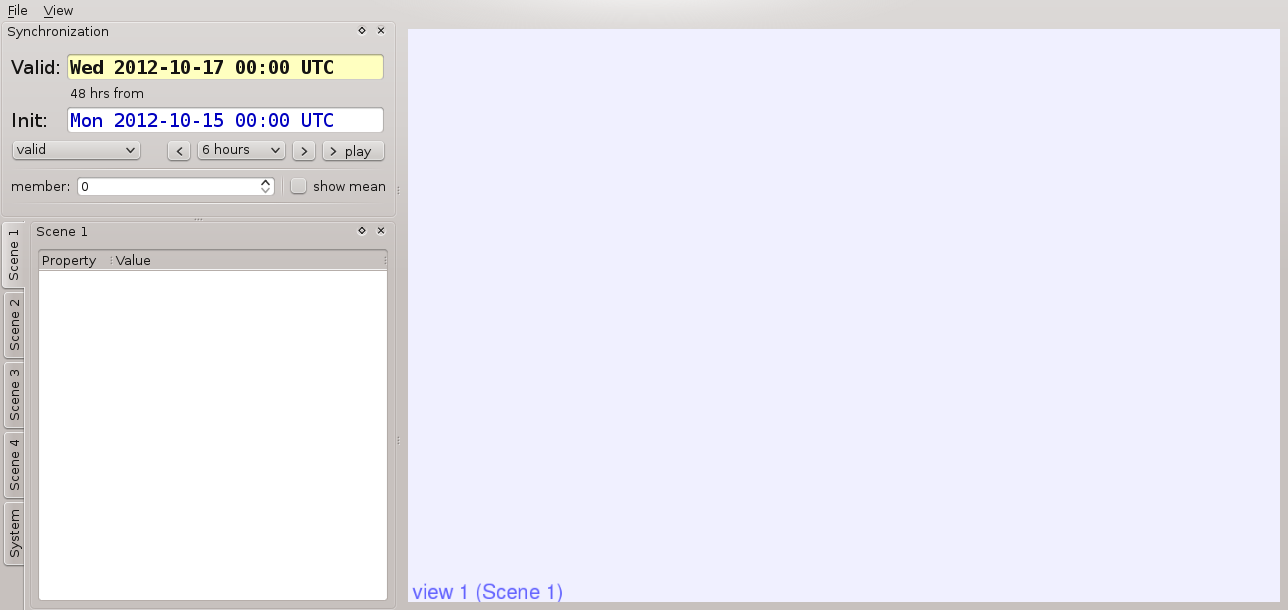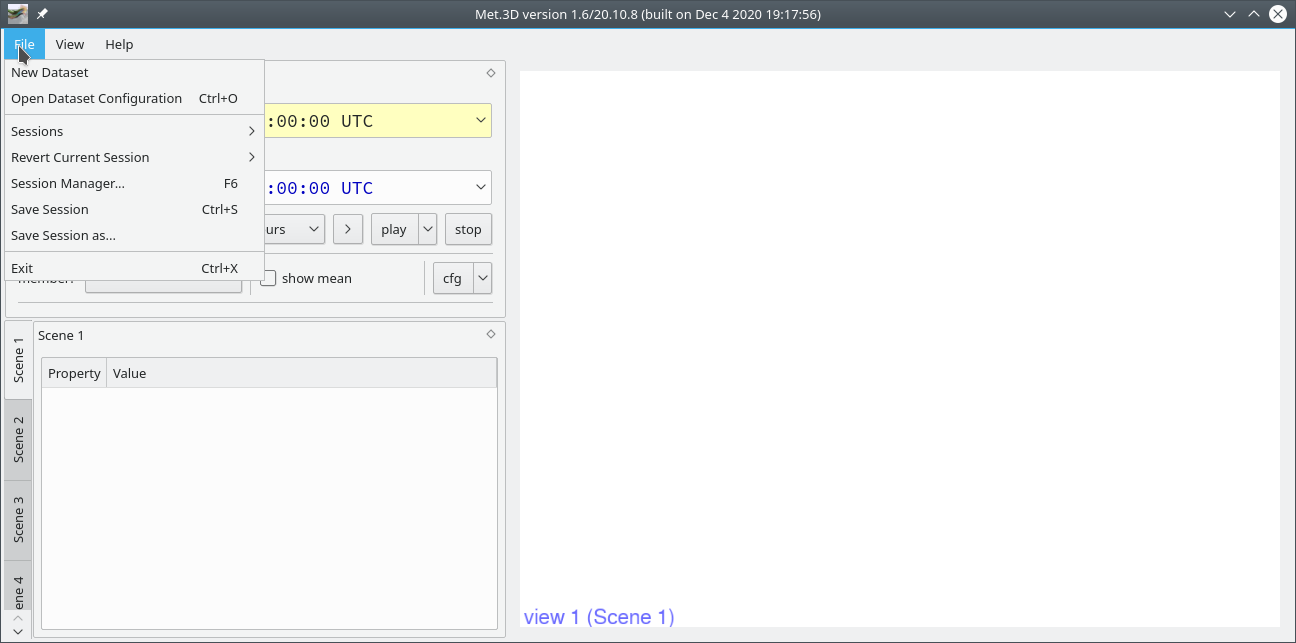
Fig. 1: The (empty) Met.3D main window that appears when first starting the software.
This page guides you through first steps with Met.3D after you have installed the software. Please also refer to the slides at Slides: Introductory Met.3D tutorial.
Note: The screenshots on this page may be taken with different versions of Met.3D. You may observe small changes in the user interface in the current version you are using. |
For the first steps with Met.3D, simply start the software by calling
$ ./met3D |
You will see some debug and info output on the console. Fig. 1 shows the Met.3D window that appears on first start-up. It contains an empty visualization area.

Fig. 1: The (empty) Met.3D main window that appears when first starting the software.
Next, add first visualization objects to the empty visualization area. In Met.3D, visualization objects are called actors. Actors represent, for example, a graticule, a base map, a 2D horizontal or vertical cross-section, or 3D isosurfaces. Currently available actors are listed in Visualization objects ("Actors"). Actors are grouped into scenes, which are simply a collection of actors. A single actor can be assigned to one or to multiple scenes. A scene can be visualized by one or by multiple scene views, which are the visualization areas in the Met.3D window. In Fig. 1, one scene view (“view 1”) is visible. It displays “Scene 1”, which currently does not contain any actors. To add actors to this scene, follow these steps:




The configured base map actor can be saved to an actor configuration file, so that the configuration steps do not have to be repeated each time a base map actor is required (this is particularly important if more properties than just the path to a map file have to be set for a given actor). In the base map actor’s “configuration” group, select the “save” entry. For example, create a new subdirectory ~/met3d/actors/ in your Met.3D home directory (see installation), and store the configuration to basemap_default.actor.conf. All actor configuration files need to end with .actor.conf.
To check whether the configuration has been stored successfully, open the scene management dialog again. Select the base map actor in the list of actors in the “Actor settings” section and click “remove”. Next, click “create from file” and select the file that you have just stored. The actor reappears in the list and can be reassigned to “Scene 1”.
Met.3D provides standard mouse interaction techniques to change the observer’s point of view within a scene view. Hold the left mouse button and drag to rotate the scene, the right button to pan, and use the scroll wheel to zoom.
Many default settings of the user interface can be changed by using customized configuration files for the Met.3D "frontend". For example, a frontend configuration file can be passed on the command line:
An an example, the default mouse interaction for navigation can be changed in the See the default file provided with Met.3D for further examples: |
The number and layout of displayed scene views can be changed by selecting one of the presets in the “View” menu (the preset configurations in the menu are also available through the keyboard short-cuts Alt+0..6). The default maximum number of scene views is four. For example, Fig. 6 shows the layout “one large view and three small views” (Alt+5).

Fig. 6 Met.3D window layout with one large and three small scene views. Views 1, 2 and 3 all show “Scene 1”, but from different viewpoints.
Similar to actor configurations, viewpoints (camera positions) can be saved to file and restored at a later time. To save a given viewpoint, select the “System” tab on the left of the Met.3D window. Similar to actor properties, properties affecting the scene views are arranged in a property tree. Open the property for the scene view for which you would like to save the camera, and choose the “modify camera/save” property.
Multiple scene views can show the same scene. In the example in Fig. 6, views 1, 2 and 3 all show “Scene 1”, but from different viewpoints. To achieve this, open the scene management dialog and specify the scenes that the views display in the lower left area of the dialog (cf. Fig. 2). Also, in view 3 the vertical scaling of the scene is different to views 1 and 2. The vertical scaling can also be changed in the “System” tab on the left side of the Met.3D window. As an example, modify the “rendering/vertical scaling” parameter for view 1 and observe the difference. With “interaction/sync camera with view”, it is possible to synchronize the camera viewpoints of two scenes. This is useful if two different scenes are to be examined from the same viewpoint.
Actors can be assigned to multiple scenes by selecting the corresponding scenes in the scene management dialog (Fig. 3). This way, actors such as graticule, base map or volume bounding box can be shared among different scenes (representing “static” content) and combined with different forecast actors (“dynamic” content) in the individual scenes.
For actors that allow interaction with the user, the scene views provide an “interaction mode”. The interaction mode can be enabled by pressing “i” while a scene view is selected, by double-clicking in the view, or by checking the corresponding property in the scene view’s property tree. While the interaction mode is enabled for a scene view, the text “Interaction mode” appears at the bottom of the view and the camera is frozen.
As an example, the “movable poles” actor supports user interaction. It allows the user to move a pole within the scene by dragging a handle attached to a pole. The following steps add the actor to the current configuration:


Next, we add a horizontal cross-section that displays some gridded simulation data (e.g., of a numerical weather prediction). The goal is to create a forecast product that shows colour-coded wind speed, overlain with contour lines of geopotential height and wind barbs.
Met.3D uses the notion of a data pipeline to access gridded data, e.g. those from a numerical weather prediction model. A data pipeline realizes access to a dataset that can contain multiple simulation variables, time steps, ensemble members, etc., in a single or in multiple files in NetCDF or GRIB format. Supported file types and grid types are described in more detail in Data handling.
Data pipelines can be created at runtime or in a configuration file and loaded on start-up of the software. Here we use the simple option to load a dataset at runtime: Select "Add new dataset" from the "File" menu, and fill in the necessary fields in the dialog that appears.
TODO: Add screenshot and description of GUI interface.
We assume the dataset being registered with the data source identification ECMWF ENS EUR_LL10.


ECMWF ENS EUR_LL10 ENSFilter and the variable Windspeed_hybrid. The suffix “ENSFilter” in the data source name indicates that in the data pipeline, a module that computes statistical quantities from the ensemble (e.g. mean or standard deviation) has been attached to the original dataset. Confirm the forecast parameter selection. In the follow-up dialog about a synchronization control select “Synchronization” to synchronize the variable with the global time and ensemble settings.

Geopotential_height_hybrid. For this variable, we set “render mode” to “line contours”. Potential contour values can be specified in the text fields “thin contour levels” and “thick contour levels”. The strings can either be a list of values (e.g. 5000,5500,6000) or three values of format [from,to,step]. An example of the latter is [0,26000,40], which will display a contour line every 40 m between 0 and 26000 m. Note that the range of values is chosen to reflect all possible values that might be encountered at any vertical location of the section. Met.3D will recognize which of the values are applicable to a given elevation and only render the actually visible lines. Put [0,26000,40] into the “thin contour levels” field and [0,26000,200] into the “thick contour levels” field. The result is shown in Fig. 13.
u-component_of_wind_hybrid and v-component_of_wind_hybrid. Leave the “render mode” for both variables set to “disabled”. Instead, open the “actor properties/wind barbs” property group of the horizontal section actor. At the bottom of the group, assign the u and v-components to the corresponding fields and click on “enabled”. For the screenshot in Fig. 14, I have also changed the colour of the barbs to blue.
The forecast product has been completed. Switch to actor interaction mode (double click in the scene view) to drag the section up and down, or modify the “actor properties/slice position” property, and use the time and ensemble navigation buttons in the top left of the Met.3D window to change time and/or ensemble member. Of course, the horizontal section configuration can be saved to a configuration file, a saved horizontal section actor configuration can be loaded at runtime in the scene management dialog. Alternatively, it can be listed in the frontend.cfg file to be loaded during start-up.
You can also have multiple instances of an actor in a scene. Fig. 15 shows an example of two horizontal sections stacked on top of each other (the lower one at 925 hPa and the upper one at 200 hPa). The pole is placed in the centre of the low pressure system at 925 hPa, its intersection with the upper section showing the relation of the position of low-level centre to the jet stream.

Fig. 15 Two identical horizontal sections stacked on top of each other. The vertical pole illustrates the relation between low pressure centre at 925 hPa and the jet stream at 200 hPa.